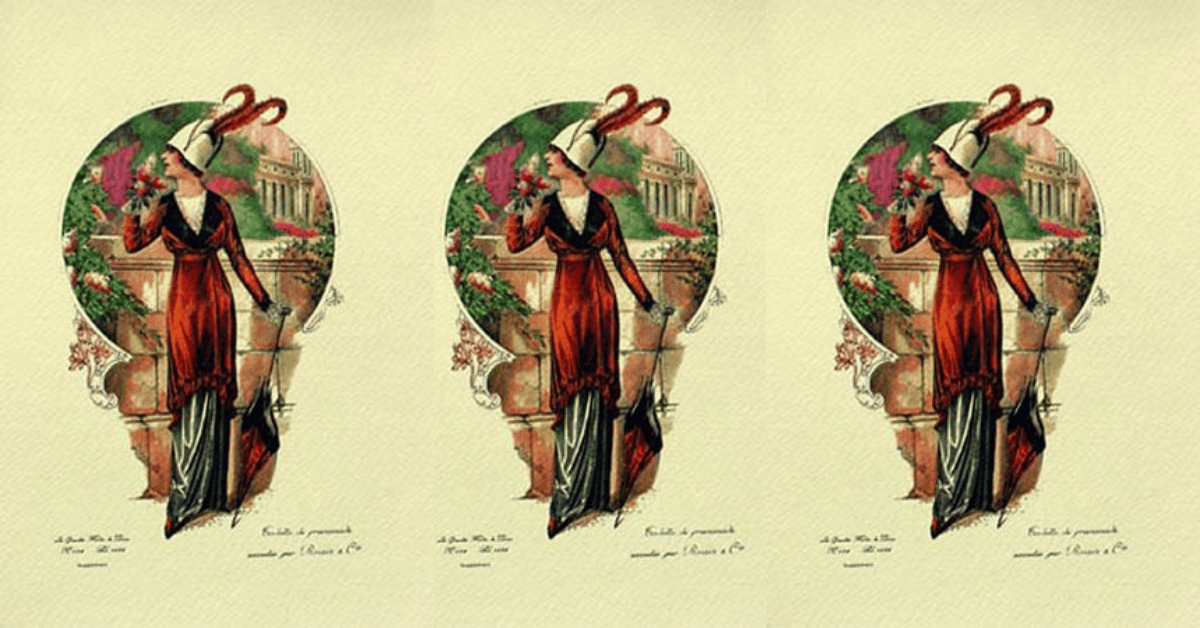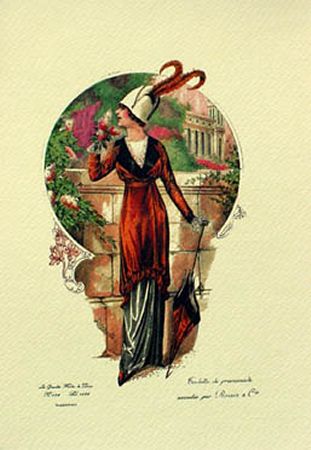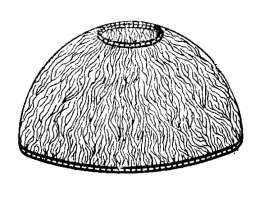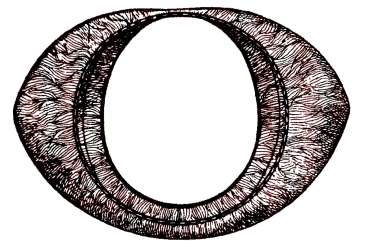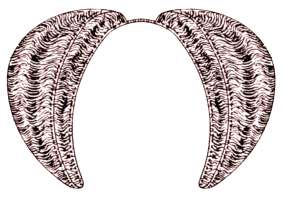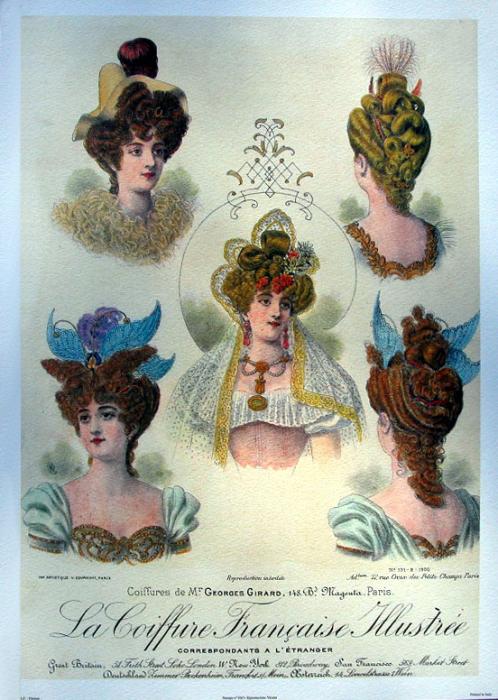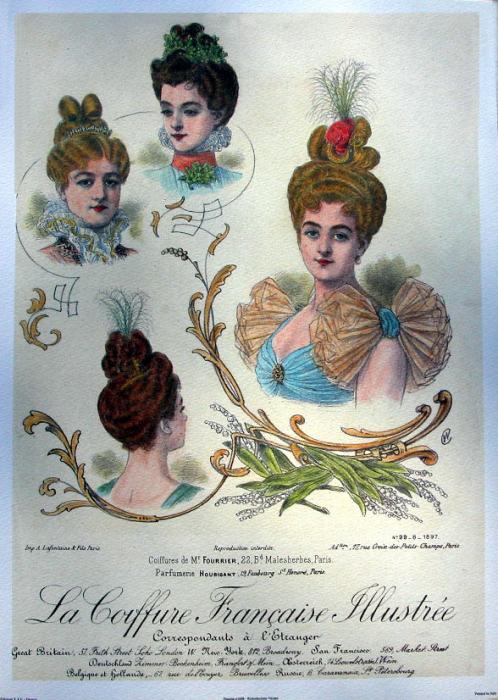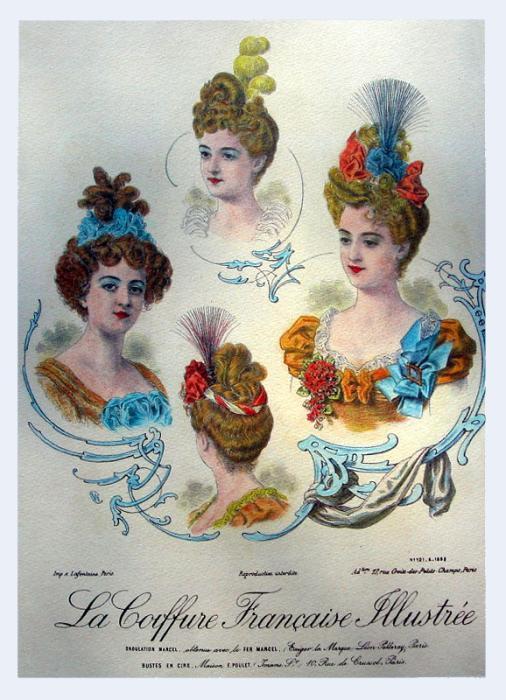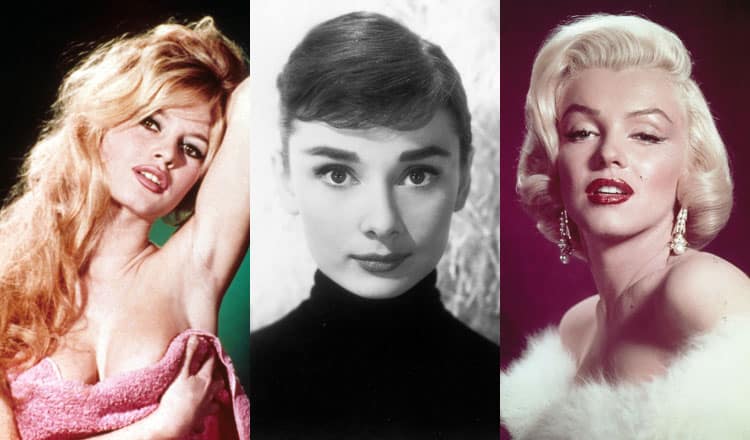Hats Fashions of the Early 20th Century - The 1st Decade
Hats during the Edwardian period were not as universally wide as is sometimes thought. The new century began with a continuation of art nouveau influence in fashion and as skirts swirled around the feet of women forming fans like bell flowers, so did the hats swirl and swoop around the head.
Lavish brims swept around the face creating an illusion of a hat suspended as if by magic on the head. The hat was often an amorphous mass swathed in tulle and smothered in flora, ribbon rosettes, or plumage. After 1903 large lace veils gave an impression of the hat being a frothy mass.
Hair Contribution to the Hat Silhouette
The shapeless nebulous appearance of the hat in part existed because of the work of hairdressers, who created a mass of supports for women to build their own hair-over. Women or their maids collected the combings of hair from their hairbrush and stored it for future use.
Pompadour Hair Frame Supports
By 1902 supports called pompadour frames were easy to buy and these were used as a base for the style and a woman’s own hair was built up and smoothed over the base. The combings were added when extra matching hair was needed to get just the right effect.
The volume these contraptions enabled meant that the hats had a great support to rest on and so they gave an impression of often appearing to be hovering when in fact they rest on a substantial and fairly firm structure..

Even so hatpins were essential. With the pompadour frame in place hatpins could be threaded through and find a safe anchor.
After 1904 the width of hats decreased, but concentrated instead on the height until 1907. These smaller hats had trimmings that highlighted the important fashion feature of height. So between 1905 to 1906 height in elegant occasion hats with a somewhat narrower width can be an important aspect of dating a photograph.
After 1907-8 wider hairstyles with central partings and side hair that fanned out over the ears meant that wider brimmed hats were introduced to balance the fuller hair silhouette.
Merry Widow Hat
1907 - 1908 saw the start of a new body silhouette called the Empire or Directoire where the long columnar outline that tapers to the feet is contrasted with the big Merry Widow picture hat. The fashion designer Lucile had designed the original widow hat for an operetta in 1907, but it influenced hat fashions for 3 more years. It was always black and encased in filmy chiffon or organdie and festooned in feathers.
Black Ascot
On May 6, 1910 King Edward VII died and a few weeks later there was a scheduled race meeting at Ascot. So 1910 saw the famous and memorable black Ascot meeting where all participants wore black and large wide picture hats.
Lingerie Hats Versus Day Hats
Lingerie hats made from muslin or froths of lace appeared about 1904 and were ideal for those able to idle away time in a perpetual summer whether abroad or at home. They were perfect with lingerie dresses in fine white lawns and linens in white, ivory, cream or ecru. If we call to mind women wearing these dresses and hats they seem to be a vision from another planet, another time another world.
What we need to remember is that in the Edwardian era wearing white was a symbol of wealth, as whites needed laundering and laundry needed the efforts of maids who spent hours scrubbing out grass stains on soiled hems wear ladies had strolled lawns.
Lingerie dresses were in effect status symbols that made a statement. It visually told the onlooker that the wearer could afford to pay someone to launder their clothes.
However for more modest day wear and often in winter, the toque was a favourite choice for many women. It was more and more acceptable to participate in sports, particularly bicycle riding. For these activities panamas, boaters, felt homburgs and sectioned pancake berets resting on a flat brim were all used for golf, motor cars and cycling.
Wider period hats in general became fashionable and were bedecked with an abundance of large cabbage rose, poppies or gerberas all overwhelming the crowns. Hat purchasing amid the Edwardian wealthy was a statement of conspicuous consumption. Every type of trim possible was used throughout the Edwardian era, from lace, to whole birds to bunches of cherries, blackberries to rosettes and ribbon streamers.
Turbans

We cannot ignore Poiret’s completely new famous maharaja turban design. In 1907 Poiret was instrumental in setting a trend that would begin the concealment of hair when he dressed his models in Directoire columnar styles and turbans. By 1910 for evening turbans were all the rage and gave an exotic eastern influence which had originated in the oriental fashion movements as a style depicted by Poiret after the Ballets Russe.
Smaller Toque Hats 1911 -1912
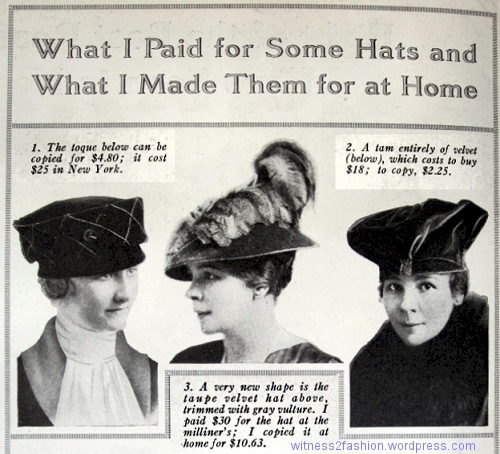
By 1911 hats became much smaller, although large wide picture hats were still worn for dressy functions. These smaller hats of 1911-12 were adorned with stiff spiky hussar plumes and fan effects of ostrich feather.
By 1913 two long narrow plumes called Mephisto feathers gave many hats a curious military quality.
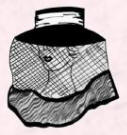
From 1914 the toques developed into tall toques and these were worn with the fashionable high collars of the day. More feminine styles included wider styles with deep crowns worn low on the head to hide all hair.

Once the war started other hats developed military tendencies and by the end of the war tricornes and postillion hats were popular having first been adopted by war widows who added black veiling. Soon sophisticated women adopted them so variations on the veiled styles became the height of chic.
The cloche hat was fashionable from 1908 to 1933 was one of the most extreme forms of millinery ever with an appearance that resembled a helmet. As early as 1908 close fitting hats with deep crowns that clung over the brow had emerged and as the war years progressed. At both the start and end of World War 1 the close head fit became even snugger. From 1916 the cloche was firmly established as a style women wore a great deal.
1910s American Fashion
clothes to hats.
The 1910s american fashion was still largely influenced by European styles, primarily French fashion, which dictated the trends of the era.
Fashion communication and export dried up between Paris and New York in the 1914-1918 war. Necessity meant that America sought out its own talent and a flurry of young designers emerged with new fresh and innovative designs that had style and chic that Manhattan women embraced. This was the real start of original American fashion produced on home ground and covered everything from
Sketches of Edwardian Hair and Hat
Hairstyles like dress fashions, often change gradually, moving slowly from one line to another. These are some drawings of hair styles circa 1900-1914. Each row shows how hats and hairstyles evolve during the Edwardian era.
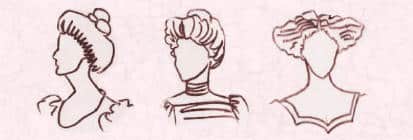
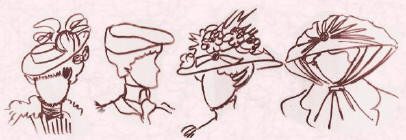
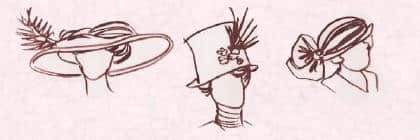
Hairstyles 1901-1914
Pads and frames of false hair helped the hairstyle of this era appear full and soft with the promise of being luxurious caught up tresses.
The pompadour style continued in the early Edwardian years and was achieved not only by supports, but by back combing. All the back hair was pulled together into a plait or flat coil and drawn onto the crown of the head.
The 'Transformation' Pompadour Style
By 1902 a product called a transformation was being used. Made of natural hair the product was waved and could literally transform any hairstyle into one of abundant wavy hair. The transformation support often referred to as a pompadour frame was easy to buy.
It was used as a base for the style and a woman’s own hair was built up and smoothed over the base.
The volume these contraptions allowed, meant that the hats had a great support to rest on and so they gave an impression of often appearing to be hovering when they rested on a firm foundation.
There was a wider range of hair styles than we generally think of when we imagine an Edwardian woman in our mind's eye. We tend to think of someone who looks like this sketch, but there was a huge range of variation in styles then just as there is today.
Look at the header on this page to see an unusual twist on the pompadour theme. That style is reminiscent of 1830's Apollo Knots.
At night hair had to be even higher. So plumes and ornaments that helped achieve the illusion of height were de rigueur.
Edwardian Era Hair Styles and Edwardian Evening Hair With Ornamentation.
Fashion Plates of elaborate very late Victorian and Edwardian hairstyling using hair ornamentation, aigrettes, feathers and frame supports.
For information specific to this late Edwardian era, you may find it useful to read the general page on La Belle Époque 1895-1914 Fashion and my other web pages in the same section.
Curling Edwardian Hair
Most women still curled their hair using curling tongs which their sometimes zealous maids overheated and cause many a singed head. But a new feature was on the horizon and this was the Nestlé permanent wave. Women would sit attached to Karl Nessler’s machine for up to 12 hours to achieve an early permanent and this endurance test can compare to some of the hair extension sittings that people go through today. Women are ever vain for the sake of fashion!
Width was essential to all hair styling of the period. The hats were so wide they demanded support. The transformation frames women used under the hair and which they then covered with their hair were important in acting as a rigid support for a heavily adorned hat.
By 1911 hairstyling began to follow the natural head shape much more and finally the ears began to be covered. New styles followed the trends for Mediterranean and Near Eastern influence.
This all led to the Grecian styling which took the hair to the back of the head. This style was usual by 1913 and remained a popular and unfussy way of drawing the hair back during war years. The hairstyle on the woman below is quite similar to styles worn until 1918.

Bandeaux
Attractive bands or bandeaux made of embellished fabric were first seen during this timeframe and they continued as hair ornamentation well into the 1920s. Many of them acted like swathes of fabric after styles set by Poiret.
Some of the headbands were very narrow jewel strips and matching combs completed a hair set. None of the hairstyles of the day would have been accomplished without firm hair pins made of much heavier wire gauge than those used in hairpins today.
